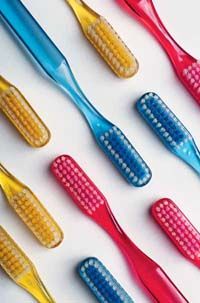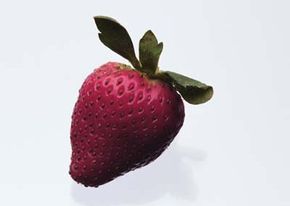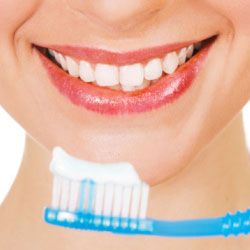Now that you've got a clear understanding of what's involved in proper oral hygiene, you're on the path to healthy teeth and gums. Following are some helpful home remedies for tartar and plaque that use foods and condiments you'll find in the kitchen.
Home Remedies from the Cupboard
Coconut oil. Massage this into sore gums for relief.
Salsa. The spicier, the better. Foods that make your mouth water actually fight dental decay. They stimulate the salivary glands, and all the extra saliva cleans your teeth and gums. And if that salsa is too hot, the water you'll drink to cool the burn will clean your mouth, too.
Salt. Dissolve 1 teaspoon salt in 1 cup warm water, and rinse your mouth with it to help treat bleeding gums, canker sores, and toothache. Salt makes a great whitening toothpaste, too. Pulverize salt in a blender, food processor, or coffee grinder, or spread some on a cutting board and roll it with a pastry rolling pin to crush it into a fine sand-like texture. Mix 1 part crushed salt with 2 parts baking soda, then dip a dampened toothbrush into the mixture and brush your teeth. Keep the powder in an airtight container in your bathroom. This mixture also helps remove plaque.
Sesame oil. Gargling with warm sesame oil is an Ayurvedic treatment--the holistic system from India--for gum disease. Take a mouthful and swish it around twice a day, then rinse. It's also said that this simple gargle can reduce cheek wrinkles. What a great bonus!
Vinegar. Here's an easy (although temporary) toothache fix. Try rinsing your mouth with a mixture of 4 ounces warm water, 2 tablespoons vinegar, and 1 tablespoon salt.
Home Remedies from the Drawer
Spoon. Brushing or scraping your tongue is an important part of your oral hygiene routine. It rids your mouth of bacteria and food particles, and it stimulates your salivary glands to wake up and get to work. Use a spoon to scrape from the back of the tongue to the front, repeating until you've covered the entire area.
Home Remedies from the Freezer
Ice. That's the last thing you want to stick on an aching tooth, isn't it? Well, don't stick it on your tooth; use it on your hand. Rub an ice cube in the soft spot between your thumb and first finger. This acupressure treatment may stop tooth pain. If your jaw is really throbbing and swollen, though, an ice pack to the face for about ten minutes every hour will help relieve both the pain and the swelling. Just be careful, as rapid cooling can increase pain. If that doesn't work, try moist heat.
Home Remedies from the Refrigerator
Apples. Munching on a raw apple an hour after a meal cleans the teeth and helps heal the gums.
Cheese. You know that nasty bacteria that's just waiting to take a whack at your tooth enamel? Cheese is their sworn enemy. First, it stimulates the salivary glands to clean the mouth. According to studies, just a few ounces of hard cheese eaten after a meal may protect against decay. There's also evidence to suggest that fatty acids in cheese may have antibacterial properties. And finally, cheese proteins may actually coat and protect tooth enamel. So, here's another reason to "say cheese"!
Figs. To "strengthen" your teeth, eat 4 figs at one time, once a day. Chew well and slowly. This stimulates the saliva flow and cleanses the mouth.
Lemon juice. Squeeze the juice of half a lemon into a cupful of water and drink to staunch bleeding gums and gingivitis. Don't take lemon juice full strength, as it can erode tooth enamel.
Melon. Any melon will do. One hour after eating, chew some melon slowly. It will help stop gums from bleeding.
Milk. Milk is a good source of calcium, an essential mineral for strong teeth and bones. Drinking a glass of "moo juice" can help promote dental health. (Note: Milk is mildly acidic, so don't put your baby to bed with a bottle; it may cause severe decay.) While you're in the fridge, check for these other calcium-packed foods: yogurt, broccoli, Swiss chard, and salmon.
Strawberries. They're a wonderful tooth whitener. Rub the juice on the teeth and leave for five minutes. Then rinse off with warm water that has a pinch of baking soda dissolved in it.
Tea bag. Black tea contains fluoride that can suppress the growth of bacteria that cause decay and dental plaque, the sticky white film that forms on your teeth. (When it hardens, it's called tartar.) Drop a tea bag of black tea into a cup of hot water, and let it brew for six minutes. This will allow the maximum amount of fluoride to escape into the water. Squeeze the tea bag into the water before discarding it to get that last little bit of fluoride. Use the tea as a rinse to prevent plaque buildup after you eat sweets.
Watercress. Chew fresh watercress several times a day to treat sore or bleeding gums.
Home Remedies from the Spice Rack
Allspice. It helps relieve toothache. Wet your finger and dip it into the spice, then rub it along the gum line near the aching tooth. You can also steep some in a glass of warm water, then rinse your mouth with it. Not only does this rinse relieve pain, it also freshens your breath.
Cloves. Cloves contain eugenol, a chemical with natural antiseptic and anesthetic properties. That explains why ground cloves have been used to relieve toothaches for thousands of years. Moisten 1 teaspoon powdered cloves in olive oil and pack it into an aching cavity. Dentists still use a mixture of eugenol and zinc oxide before applying amalgam when filling teeth.
Coriander. This spice, as well as thyme and green tea, has antibacterial properties. Brew a tea from your choice of the three and use as a mouth rinse after meals.
Sage. Add 2 teaspoons sage to 2 cups water, then boil. Cool for 15 minutes, then swish in your mouth for several minutes. Sage has an antibacterial property that may reduce decay.
Sesame seeds. Chew a handful slowly but don't swallow. Brush your teeth with a dry toothbrush, using the chewed seeds as you would a toothpaste. They will both clean and polish.
Put on a happy smile -- and keep that smile happy -- by putting the home remedies outlined in this article to good use.
For more information on tartar and plaque and how to combat them, try the following links:
- Visit our Home Remedies page to learn about all of our home rememdies and the conditions they treat.
- If you are suffering from painful or even bleeding gums, there are some herbs that may be in your garden right now that can alleviate or eliminate these problems. Learn how in Herbal Remedies for Dental Problems.
- For an in-depth explanation of dental disease, go to our How Dental Disease Works page.
- Find out how regular cleaning prevents problems by understanding how oral hygiene works.
- Learn effective home remedies that help you cope with tooth pain naturally.
ABOUT THE AUTHORS:
Timothy Gower is a freelance writer and editor whose work has appeared in many publications, including Reader's Digest, Prevention, Men's Health, Better Homes and Gardens, The New York Times, and The Los Angeles Times. The author of four books, Gower is also a contributing editor for Health magazine.
Alice Lesch Kelly is a health writer based in Boston. Her work has been published in magazines such as Shape, Fit Pregnancy, Woman's Day, Reader's Digest, Eating Well, and Health. She is the co-author of three books on women's health.
Linnea Lundgren has more than 12 years experience researching, writing, and editing for newspapers and magazines. She is the author of four books, including Living Well With Allergies.
Michele Price Mann is a freelance writer who has written for such publications as Weight Watchers and Southern Living magazines. Formerly assistant health and fitness editor at Cooking Light magazine, her professional passion is learning and writing about health.
ABOUT THE CONSULTANTS:
Ivan Oransky, M.D., is the deputy editor of The Scientist. He is author or co-author of four books, including The Common Symptom Answer GuideBoston Globe, The Lancet, and USA Today. He holds appointments as a clinical assistant professor of medicine and as adjunct professor of journalism at New York University. (McGraw-Hill, 2004), and has written for publications including the
David J. Hufford, Ph.D., is university professor and chair of the Medical Humanities Department at PennsylvaniaState University's College of Medicine. He also is a professor in the departments of Neural and Behavioral Sciences and Family and Community Medicine. Dr. Hufford serves on the editorial boards of several journals, including Alternative Therapies in Health & Medicine and Explore.
This information is solely for informational purposes. IT IS NOT INTENDED TO PROVIDE MEDICAL ADVICE. Neither the Editors of Consumer Guide (R), Publications International, Ltd., the author nor publisher take responsibility for any possible consequences from any treatment, procedure, exercise, dietary modification, action or application of medication which results from reading or following the information contained in this information. The publication of this information does not constitute the practice of medicine, and this information does not replace the advice of your physician or other health care provider. Before undertaking any course of treatment, the reader must seek the advice of their physician or other health care provider.





